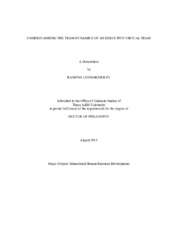| dc.description.abstract | Organizations of all types are now able to operate in virtual capacities through time, space, and distance across multinational boundaries; therefore, geography no longer limits business functioning. In fact, many corporate executives and boards employ virtuality in their work regimen. Therefore, organizations employ virtual executives to work teams with ideal skill sets to effectively persevere and complete tasks through distance, space, and time. The purpose of this study was to identify and yet understand the experiences of executive multinational, virtual board members working as a team in a virtual environment. Through this research the virtual dynamics of the virtual team have been studied, prodded, purposely mismatched, and weaved together to understand the culture of the virtual environment in which the team members interact and perform duties. With this particular board, there has been a history of previous work experience or exposure in some capacity; however, it has no great impact on their interaction and work with the entire board.
In this study, an exploratory look at the experiences, perceived team dynamics, and strategies used to successfully function as a virtual team are highlighted from a qualitative perspective. The purpose is to describe the individual perspectives of how a multinational executive virtual team best works.
The findings of this study reveal that there are many ways to communicate utilizing technology, but the objective for this virtual team is to be multidimensional in use. That means that honest communication is necessary for the board to perform at their optimal level. Therefore, the theoretical framework is based on team performance as a teamwork process-based construct which depends on communication, relationship, and trust to add success for virtual teams The framework results in three step process for team flow and success i.e., the importance of face-to-face meetings; advantages of virtual teaming; and challenges of virtual teaming to result in virtual team performance dependent on the team having communication, relationship, and trust present. | en |


